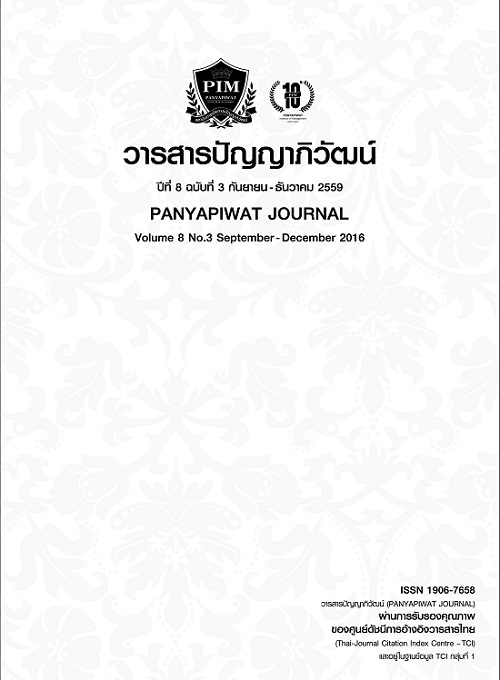อัตลักษณ์ชาติพันธุ์ชาวสยามในมาเลเซีย
Main Article Content
บทคัดย่อ
งานศึกษาชิ้นนี้ใช้มุมมองเชิงต่อรองในการศึกษาศักยภาพการดำรงอยู่ของชุมชนชาวสยามในประเทศมาเลเซีย เพื่อวิเคราะห์ความสัมพันธ์ระหว่างการสื่อสาร อัตลักษณ์ และพื้นที่พรมแดนของกลุ่มชาติพันธุ์ชาวสยามในประเทศมาเลเซียด้วยจุดยืนที่ว่าด้วยพลังของการสื่อสาร กระบวนการอัตลักษณ์ที่ไม่หยุดนิ่งตายตัว หากแต่มีการปรับเปลี่ยนลื่นไหลตามแต่บริบทและเงื่อนไข ภายใต้แนวคิดสายสกุลประกอบสร้าง โดยพบว่าชาวสยามยังคงมีการสื่อสารเพื่อประกอบสร้างอัตลักษณ์ชาติพันธุ์ภายใต้เงื่อนไขและเพื่อสิทธิประโยชน์ที่แตกต่างหลากหลายอย่างเป็นพลวัต ท่ามกลางการปะทะสังสรรค์ระหว่างวัฒนธรรมกับกลุ่มชาติพันธุ์อื่นในรัฐชาติมาเลเซีย นอกจากนี้การเปลี่ยนผ่านของยุคสมัยและพัฒนาการของระบอบการเมืองการปกครอง มิติทางเศรษฐกิจ และโครงสร้างสังคมวัฒนธรรมเพื่อสร้างความเป็นเอกภาพของประเทศมาเลเซียย่อมส่งผลต่อการดำรงอยู่ของอัตลักษณ์ชาติพันธุ์ชาวสยาม ชาวสยามจึงมีการสื่อสารอัตลักษณ์ชาติพันธุ์ เพื่อนิยามตัวตนและกำหนดตำแหน่งแห่งที่ของกลุ่มชาติพันธุ์ชาวสยามในสังคมพหุวัฒนธรรมของประเทศมาเลเซียให้ดำรงอยู่ได้อย่างมีอัตลักษณ์ศักดิ์ศรี
This study conducted with the negotiate approach to study the potential existence of Siamese – Malaysian's ethnic identity in Malaysia, analyze the relation between communication, identity and ethnic boundarie of Siamese - Malaysian in Malaysia by the standpoint of communication power, the dynamic of identity process which shifting and multi-faced under the constructionism approach. The finding reveal that Siamese – Malaysian have constructed their ethnic identity under various conditions and benefits. Moreover, the passage of time and the development of democratic political, economic and structure of social culture build the unity of the country that would affect the existence of Siamese – Malaysian's ethnic identity. Therefore, ethnic identity of Siamese - Malaysian is communicated in order to define the identity and the position of their ethnic identity to live with dignity in the multicultural society of Malaysia.
Article Details
“ข้าพเจ้าและผู้เขียนร่วม (ถ้ามี) ขอรับรองว่า บทความที่เสนอมานี้ยังไม่เคยได้รับการตีพิมพ์และไม่ได้อยู่ระหว่างกระบวนการพิจารณาลงตีพิมพ์ในวารสารหรือแหล่งเผยแพร่อื่นใด ข้าพเจ้าและผู้เขียนร่วมยอมรับหลักเกณฑ์การพิจารณาต้นฉบับ ทั้งยินยอมให้กองบรรณาธิการมีสิทธิ์พิจารณาและตรวจแก้ต้นฉบับได้ตามที่เห็นสมควร พร้อมนี้ขอมอบลิขสิทธิ์บทความที่ได้รับการตีพิมพ์ให้แก่สถาบันการจัดการปัญญาภิวัฒน์หากมีการฟ้องร้องเรื่องการละเมิดลิขสิทธิ์เกี่ยวกับภาพ กราฟ ข้อความส่วนใดส่วนหนึ่งและ/หรือข้อคิดเห็นที่ปรากฏในบทความข้าพเจ้าและผู้เขียนร่วมยินยอมรับผิดชอบแต่เพียงฝ่ายเดียว”
เอกสารอ้างอิง
Andaya, B. W. & Andaya, L. Y. (2001). A history of Malaysia. Hampshire: Palgrave Macmillan.
Angrosino, M. (2007). Doing Ethnographic and Observational Research. London: Sage.
Brown, D. (1994). The state and ethnic politics un Southeast Asia. USA: Routledge.
Castells, M. (2010). The power of identity. UK: Blackwell.
Fuengfusakul, A. (2003). Identity: a review of the theoretical and conceptual framework.Council research, National Sociology. Bangkok: National Research Council. [in Thai]
Government of Malaysia. (2015). Unjuran populasi penduduk. Retrieved November 26, 2015, from http://pmr.penerangan.gov.my/index.php/info-terkini/19463-unjuran-populasi-penduduk-2015.html
Hinwiman, S. (2005). Summary executionsets of Philosophy and Theory of Science Communication Unit 8-15. Nonthaburi: Sukhothai Thammatirat University Printing. [in Thai]
Kaeosanit, T. (2009). Communication for maintaining cultural identity of the Siamese - Malaysian community in Kedah, Malaysia. Master thesis of Faculty of Communication of Arts, Chulalongkorn University. [in Thai]
Kaewthep, K. (2002). When the media reflect and construct culture.Bangkok: Saladeang. [in Thai].
___________(2012). Old Media - New Media: semiotic, identity, ideological.Bangkok: Pabpim. [in Thai].
___________(2014). Science of Media and Cultural Studies. Bangkok: Edison Press Products. [in Thai]
Kanjanapun, A. (2012). Multiculturalism in the context of social and cultural change. Office of promote and academic support 10, Chiang Mai. Department of social development and Welfare, ministry, social development and human security. [in Thai]
Kuroda, K. (2002). The Siamese in Kedah Under Nation-State Making. Retrieved November 26, 2015, from http://www.unimuenster.de/Ethnologie/South_Thai/working_ paper/Kuroda_Kedah
Pawakkapan, N. (1998). Sometimes Thai Sometime Not Thai: it is not the identity of the tangible variable. Rattasas Sarn, 20(3), 215-252. [in Thai]


